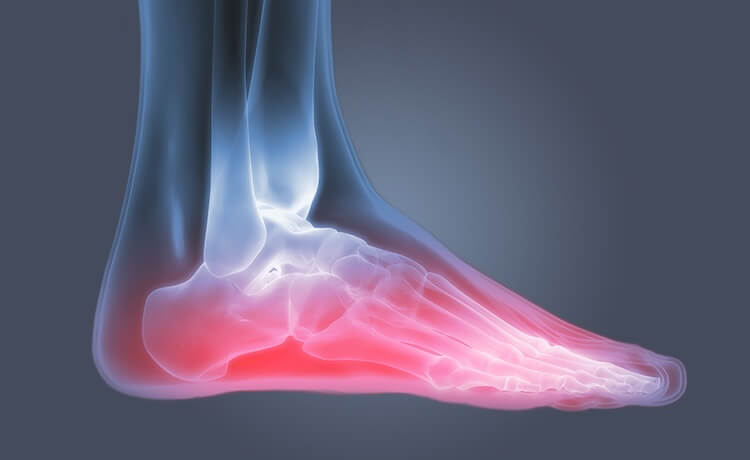What is the difference between Osteoarthritis and Rheumatoid Arthritis?

BACKGROUND
12 million people in the United Kingdom have arthritis, with the majority of patients suffering with osteoarthritis this figure is estimated to be around 80% of arthritis sufferers. The remainder of patients suffer with one of the many inflammatory arthropathies, the main player being Rheumatoid Arthritis.
THEY ARE OFTEN CONFUSED AS PATIENTS SUFFER WITH SIMILAR SYMPTOMS OF JOINT PAIN AND STIFFNESS, HOWEVER, AN ACCURATE DIAGNOSIS IS CRUCIAL FOR TREATMENT.
WHAT IS OSTEOARTHRITIS?
Osteoarthritis is a ‘wear and tear’ degenerative joint disease caused by mechanical overload with time. Joint cartilage wears away as this progresses, typically beginning later in life, with a slow gradual onset of symptoms. The result is joint damage causing pain, swelling, inflammation and bone on bone contact, instead of a nice smooth gliding joint surface.
WHAT IS RHEUMATOID ARTHRITIS?
Divergently, rheumatoid arthritis is an autoimmune disease. Our body’s immune system attacks its own joints, regardless of any wear and tear over time.
This results in swelling, stiff and tender joints, and patients may feel tired and unwell. It may also affect the integrity and composition of the body’s soft tissues such as ligaments, muscles and tendons which can become symptomatic. In the past, these changes lead to severe joint deformity and malposition of the foot and ankle as well as joints in the hands, thankfully with the advent of modern anti-rheumatic and disease modifying drugs, we are seeing less severe cases of rheumatoid arthritis related deformity.
WHAT ARE THE KEY DIFFERENCES?
Patients with both osteoarthritis and rheumatoid arthritis tend to both experience stiff joints in the morning, but these symptoms are likely to last longer than an hour with rheumatoid arthritis.
Symptoms of rheumatoid arthritis are more unpredictable, and can suddenly flare up or disappear. Osteoarthritis manifests on one side of the body first while rheumatoid arthritis often affects symmetrical joints.
Osteoarthritis also tends to affect the body’s weight-bearing or heavily utilised large joints such as shoulders, spines, hips, knees and ankles but may also affect smaller joint of the hand and foot. Most commonly, the big toe joint, a painful condition known as Hallux Limitus or Hallux Rigidus.
WHAT CAN I DO ABOUT ARTHRITIS?
Osteoarthritis is often with oral or topical anti-inflammatory (NSAID) ointments such as Ibuprofen, this can be supplemented with regular pain killers such as Paracetamol, as well as herbal or natural medicines such as Glucosamine and Chondritin.
By contrast, patients with rheumatoid arthritis might be advised to take disease modifying or biologic drugs to ‘dampen down’ the body’s immune attack on it’s own joints and soft tissues.
IF YOU HAVE A HIGH-ARCHED OR FLAT FOOT, YOUR PODIATRIST MAY ADVISE AN INSOLE OR CUSTOM ORTHOTIC TO REDUCE STRESS ON THE AREAS OF PAIN.
Your Podiatrist may inject steroid into the region to reduce the inflammatory process caused by the problem, which often relieves the pain.
Infrared multi-shot video gait analysis can be undertaken to establish what motion during walking or running is over stressing the affected structures and from this an insole or custom made orthotic may be designed and prescribed.
Your podiatrist will advise you about weight loss, activity modification and appropriate footwear.
If you have an ankle problem or tension within the Achilles tendon a physiotherapist can advise on exercises for this. Stretching and strengthening soft tissues around affected joints, such as the Achilles tendon and plantar fascia can be a very effective general treatment for many patients and your Podiatrist can make the appropriate in-house referral.
WHY DOES EXERCISE MATTER?
At OsteoGait Podiatry we advise patients to remain as active as possible. “We find activity and an exercise regime beneficial for osteoarthritis sufferers” says Mr Ravi Modha, who recommends that patients always seek advice from their GP or Physiotherapist.
“ANALGESICS MAY REDUCE THE INFLAMMATION THAT CAUSES THE PAIN, AND EXERCISE STRENGTHEN THE SOFT TISSUES SUPPORTING THE AFFECTED JOINTS.”
NHS officials advise we should do 180 minutes of moderate exercise weekly, with over-65s performing general strength and resistance training several times a week, working all major muscle groups.
However, strength training does not necessarily mean lifting weights in a gym.
It could be carrying your shopping instead of taking the bus, gardening, dancing, walking up a tall flight of stairs or a local yoga or pilates class.
An excellent program can be experienced at Sprint Physiotherapy in Kensington, who have been serving the local community for many years with both 1:1 and group Clinical Pilates.
“REGULAR PHYSICAL ACTIVITY AND EXERCISE AT EVERY STAGE OF LIFE CAN REDUCE THE RISK OF MANY MUSCULOSKELETAL CONDITIONS, INCLUDING ARTHRITIS, BACK PAIN, NECK PAIN, FALLS AND FRACTURES,”
PUBLIC HEALTH ENGLAND, 2017
WHAT IF I WANTED TO SEE OSTEOGAIT PODIATRY ABOUT MY ARTHRITIC FEET?
This six step plan for pain free feet is apart of our arthritis protocol:
- 1) Accurate diagnosis of osteoarthritis via biomechanical and video gait analysis.
- 3) Custom orthotic therapy to address the imbalance within the foot or lower limb
- 4) Footwear advice and customisation to minimise the mechanical tension on joints affected by osteoarthritis.
- 5) Specialist guided injections using corticosteroid to reduce joint inflammation and pain.
- 6) Referral for surgical consult should the above fail.
If you require advice on any of these topics or a pair of custom made insoles or orthotics for a painful arthritic feet, a flatfoot or high arched foot, click (more information).
